21.1. Safari If you want to get something done right, you have to do it yourself. At least that must be what Apple was thinking when it wrote its own Web browser, which so annoyed Microsoft that it promptly ceased all further work on its own Mac version of Internet Explorer. Safari is beautiful, very fast, and filled with delicious features. It's not, however, Internet Explorer, and so some Web sites ”certain banking sites, for example ” refuse to acknowledge its existence. (Read on for workarounds.) For the near term , therefore, it's worth keeping a copy of Internet Explorer on hand for those situations when Safari can't get its foot in the door.
Tip: Tiger doesn't come with Internet Explorer. If you don't have an old copy, Microsoft offers it as a free download from www.microsoft.com/mac/products/internetexplorer/internetexplorer.aspx.
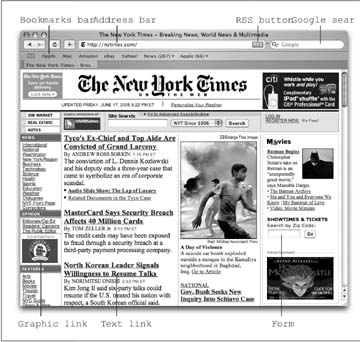 | Figure 21-1. The Safari window offers tools and features that let you navigate the Web almost effortlessly. These various toolbars and buttons are described in this chapter. One difference that may throw you if you're used to other browsers: When you're loading a Web page, the progress bar appears as a colored stripe that gradually darkens the Address bar itself, rather than as a strip at the bottom of the window. | |
21.1.1. Browsing Basics and Toolbars Navigating the Web requires little more than clicking buttons and/or those underlined blue phrases, as shown in Figure 21-1. You probably know the drill when it comes to Web browsers. When you click an underlined link ( hyperlink ) or a picture button, you're transported from one Web page to another. One page may be the home page of General Motors; another may contain critical information about a bill in Congress; another might have baby pictures posted by a parent in Omaha. Altogether, several hundred million Web pages await your visit.
Tip: Text links aren't always blue and underlined. In fact, trendy Web designers sometimes make it very difficult to tell which text is clickable, and which is just text. When in doubt, move your cursor over some text; if the arrow changes to a pointing-finger cursor, you've found yourself a link.
Some of the other Safari tips that may not be obvious: -
Graphics worth saving . When you see a picture you'd like to keep, Control-click it and choose Save Image to the Desktop from the shortcut menu. Safari stores it as a new graphics file on your hard drive. (You can specify where Safari saves downloaded pictures on the Safari Preferences General tab. In that case, the shortcut menu's wording changes to say, for example, "Save Image to 'Pictures.'")
Tip: You can also save a graphic to the desktop just by dragging it there, right out of the Safari window. If you're looking at a picture that you'd like to add to your pictures in iPhoto, Control-click the image and choose Add Image to iPhoto Library. Sweet!
-
Scroll bars . Use the scroll bar to move up and down the page ”or to save mousing, press the Space bar each time you want to see more. Press Shift-Space to scroll up . (The Space bar serves its traditional, space-making function only when the insertion point is blinking in a text box or the Address bar.) You can also press your up and down arrow keys to scroll one line at a time. Page Up and Page Down scroll in full-screen increments , while Home and End whisk you to the top or bottom of the current Web page. And if your mouse has a scroll wheel, it works, too. (Hold Shift while you're rolling the wheel to scroll horizontally .) 21.1.2. Safari Toolbars Many of Safari's most useful controls come parked on toolbars and buttons that you summon or hide by choosing their names from the View menu. Here's what they do: 21.1.2.1. Address bar When you type a new Web page address (URL) into this strip and press Enter, the corresponding Web site appears.
Note: If only an error message results, then you may have mistyped the address, or the Web page may have been moved or dismantled ”a relatively frequent occurrence in today's rapidly -changing World Wide Web.Similarly, you'll see an error message if Safari can't connect to the Internet at all . (In Tiger, this error message is a masterpiece of clarity: "You are not connected to the Internet.")In that case, click Network Diagnostics to see if Mac OS X can track down the source of your connection trouble. Once you get back online, Safari automatically loads any pages you've been waiting to read.
Because typing out Internet addresses is so central to the Internet experience and such a typo-prone hassle, the Address bar is rich with features that minimize keystrokes. For example: -
You don't have to click the Address bar before typing; just press c-L. -
You can highlight the entire address (so it's ready to be typed over with a new one) by clicking the very upper or lower edge of the Address bar text box. Alternatively, you can click the small icon just to the left of the current address, or triple-click the Address bar, or press c-L. GEM IN THE ROUGH
Let AutoFill Do the Typing | | Safari can also remember user names, passwords, and other information you type into the text boxes you encounter in your Web travels . To turn on this awesome feature, visit the Safari Preferences AutoFill tab. If you turn on "Using info from my Address Book card," whenever you're supposed to fill in your shipping address on a Web form, you can click the AutoFill button in the Address bar to have Safari fill in the blanks for you automatically. (If you don't see the AutoFill button ”see Figure 21-2 ”choose its name from the View menu, or use edit AutoFill Form to do the deed instead.) Alternatively, just click a text box ”"name," for example ”and start typing. As soon as Safari recognizes a familiar scrap of your contact information, it fills out the rest of the word automatically. (If it guessed wrong, just keep typing.) If, in Preferences, you turn on "User names and passwords," then each time you type a password into a Web page, Safari offers to memorize it for you. It's a great time and brain saver, even though it doesn't work on all Web sites. (Of course, use it with caution if you share an account on your Mac with other people.) When you want Safari to "forget" your passwords ”for security reasons, for example ” revisit that Safari Preferences AutoFill tab. Click one of the Edit buttons, and then delete the Web site names for which your information has been stored. Turn on Other Forms if you'd like Safari to remember the terms you've typed into search engines, shopping sites, online gaming sites, and so on. |
-
You don't have to type out the whole Internet address. You can omit the http: , www , and . com portions; Safari fills in those standard address bits for you. To visit NYTimes.com, for example, a speed freak might press c-L to highlight the Address bar, type nytimes , and then press Enter.
Tip: You're Web surfing, and you suddenly need to look up an appointment in iCal. What do you do?The power user opens other programs right from within Safari by typing ical :// in the Address bar ”or ichat ://, addressbook ://, or sherlock :// ”and then pressing Return or Enter. ( Unfortunately , those are just about the only Apple programs that work with this URL-launching trick.)You can also type mailto : to open a new outgoing email message in your default email program, or mailto:steve@apple.com to preaddress that outgoing message to Steve Jobs. (Of course, remember to replace that email address with someone you'd actually like to contact.)
-
When you begin to type into the Address bar, the AutoComplete feature compares what you're typing against a list of Web sites you've recently visited or that you've saved as bookmarks. Safari displays a drop-down list of Web addresses that seem to match what you're typing. To spare yourself the tedium of typing out the whole thing, click the correct complete address with your mouse, or use the down arrow key to reach the desired listing and then press Enter. The complete address you select then pops into the Address bar.
Tip: You might wonder why the View menu even offers you the chance to hide the Address bar. If it were hidden, how could you use the Web?Simple: Even with this bar hidden, you can briefly summon it by pressing c-L. Type the ad-dress you want and then press Enter to make the bar disappear again. That's good news for people with small screens ”and for Mac trivia collectors.
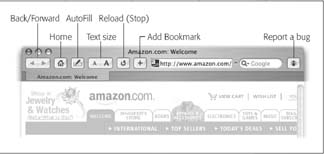 | Figure 21-2. You summon or hide these buttons by choosing View Customize Address bar and dragging buttons onto or off of the Address bar. Some of them lack text labels, but all offer tooltip labels that you can read by pointing to the button without clicking. | |
You can summon or dismiss a number of individual buttons on the Address bar, in effect customizing it (Figure 21-2): -
Back/Forward . Click the Back button to revisit the page you were just on. Keyboard shortcut : Delete, or c-left arrow, or c-left bracket . Once you've clicked Back, you can then click the Forward button (or press c-right arrow, or c-right bracket) to return to the page you were on before you clicked the Back button. Click (and hold on) the Back button for a drop-down list of all the Web pages you've visited during this online session. That pop-up menu lists the sites by name, as in "The New York Times ”Breaking News, World News & Multimedia." To view the actual addresses instead, Option-click (and hold the mouse down on) the Back or Forward button.
Tip: Instead of clicking and holding the Back or Forward button for these tricks, you can save half a second of waiting by adding the Control key as you click.
-
Home . Click to bring up the Web page you've designated as your home page (in Safari Preferences General tab). -
AutoFill . Click this button to make Safari fill in Web order forms with your name, address, and other information. See the box on Section 21.1.2. -
Text Size . You can adjust the point size of a Web page's text using these buttons. When you visit a Web site designed for Windows computers ”whose text often looks too small on Mac screens ”you can use these buttons to bump up the size. Keyboard shortcut : c-plus or c-minus. -
Stop/Reload . Click the Stop button to interrupt the downloading of a Web page you've just requested (if you've made a mistake, for instance). Keyboard shortcut : Esc or c-period. Once a page has finished loading, the Stop button turns into a Refresh button. Click this circular arrow if a page doesn't look or work quite right, or if you want to see the updated version of a Web page (such as a breaking-news site) that changes constantly. Safari re-downloads the Web page and reinterprets its text and graphics. Keyboard shortcut : c-R. -
Add Bookmark . When you find a Web page you might like to visit again, click this button. You can also press c-D, or choose Bookmarks Add Bookmark, or drag the tiny icon from the Address bar directly onto your Bookmarks bar. As shown in Figure 21-3, Safari offers to add this Web page's name (or a shorter name that you specify for it) either to the Bookmarks menu or to the Bookmarks bar described below. The next time you want to visit that page, just select its name in whichever location you chose.
Tip: Press Shift-c-D to add the bookmark to the menu instantly ”no questions asked, no dialog box presented.
You can rearrange the names in your Bookmarks menu easily: Just choose Bookmarks Show All Bookmarks (Option-c-B), or click the tiny book icon shown in Figure 21-3. In the resulting organization window, drag the bookmarks up and down. For more dramatic management tasks ”to edit, rename, or delete your bookmarks, for example ”also see Figure 21-3. 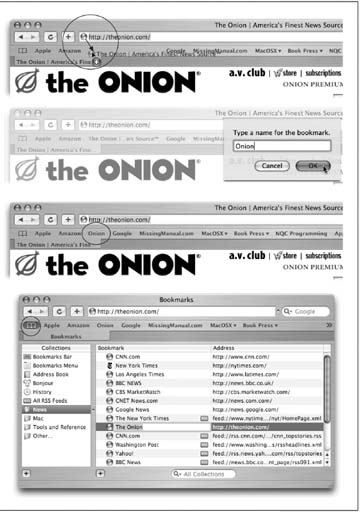 | Figure 21-3. Top: Once you've got a juicy Web page on the screen, you can drag its tiny page-logo icon from the address bar directly onto the Bookmarks bar.
Second from top: Safari realizes that you may prefer a shorter name to appear on the space-limited bar, so it offers you the chance to type in a label you prefer.
Third from top: When you click OK, the new button appears on the bar, as shown here. (You can also drag any link, such as a blue underlined phrase, from a Web page onto the bar ”or even an icon from your desktop!) To remove a button, drag it off the bar; to rearrange the icons, just drag them.
Bottom: Click the little book icon (circled) to open the Organize Bookmarks window. Here, you can drag names up or down to rearrange the list, or drag them into a "folder" that becomes a submenu in the Bookmarks menu (create one by clicking the + button below the list). You can edit a bookmark by clicking once on its name or URL, or delete one by pressing Delete. | |
-
Google Search . Here's one of Safari's most profoundly useful features ”a Search box that automatically sends your search request to Google.com, the world's most popular Web search page. Press Option-c-F to deposit your insertion point inside this rounded text box, type something you're looking for ” phony baloney , say ”and then press Enter. Safari takes you directly to the Google results page.
Tip: Click the tiny triangle at the left end of the Google bar to produce a pop-up menu of your most recent searches.
Tip: If you Control-click a highlighted word or phrase on a Web page, you can choose Google Search from the shortcut menu to search for that text. And, even cooler , this trick works in all Cocoa programs ”not just Safari.
-
Bug . Ladies and gentlemen, this is Apple at its most humble . This insect-shaped button opens a tiny "Dear Apple" box, where you can tell Apple about a Safari feature or Web page that doesn't work. If you click Options, you can even send Apple a screen illustration of, for example, a screwy Web-page layout that Safari delivered. 21.1.2.2. Bookmarks bar The Bookmarks menu is one way to maintain a list of Web sites you visit frequently. But opening a Web page from that menu requires two mouse clicks ”an exorbitant expenditure of energy. The Bookmarks bar (View Bookmarks Bar), on the other hand, lets you summon a few very favorite Web pages with only one click.
Tip: If you have a bunch of bookmarks stored in another Web browser, use that browser's export feature to save them in a file, and then use Safari's File Import Bookmarks command to save you the time of re-entering the bookmarks by hand. (Similarly, if you ever decide to dump Safari for another browser, use Safari's File Export Bookmarks command so you can easily import the bookmarks into your new browser.)
Figure 21-3 illustrates how to add buttons to, and remove them from, this toolbar.
Tip: As shown in Figure 21-3, you can drag a link from a Web page onto your Bookmarks bar. But you can also drag a link directly to the desktop, where it turns into an Internet location file . Thereafter, to launch your browser and visit the associated Web page whenever you like, just double-click this icon.Better yet, stash a few of these icons in your Dock or Sidebar for even easier access.
21.1.3. Status Bar The Status bar at the bottom of the window tells you what Safari is doing (such as "Opening page " or "Done"). When you point to a link without clicking, the Status bar also tells you which URL opens if you click it. For those two reasons, it's a very useful strip, but it doesn't appear when you first run Safari. You have to summon it by choosing View Show Status Bar. 21.1.4. Tips for Better Surfing Safari is filled with shortcuts and tricks for better speed and more pleasant surfing. For example: 21.1.4.1. SnapBack The little orange SnapBack button (  ), found at the right end of the Address bar or Google search bar, takes you instantly back to the Web page whose address you last typed (or whose bookmark you last clicked), or to your first Google results page. The point here is that, after burrowing from one link to another in pursuit of some Google result or Amazon listing, you can return to your starting point without having to mash the Back button over and over again. (The SnapBack button doesn't appear until you've actually clicked away from the first page you visited.) ), found at the right end of the Address bar or Google search bar, takes you instantly back to the Web page whose address you last typed (or whose bookmark you last clicked), or to your first Google results page. The point here is that, after burrowing from one link to another in pursuit of some Google result or Amazon listing, you can return to your starting point without having to mash the Back button over and over again. (The SnapBack button doesn't appear until you've actually clicked away from the first page you visited.)
Tip: At any time, you can designate your current page as the new SnapBack page. To do so, choose History Mark Page for SnapBack (Option-c-K).
21.1.4.2. Stifle pop-ups and pop-unders The world's smarmiest advertisers have begun inundating us with pop-up and pop-under ads ”nasty little windows that appear in front of the browser window, or, worse , behind it, waiting to jump out the moment you close your current window. They're often deceptive, masquerading as error messages or dialog boxes, and they'll do absolutely anything to get you to click inside them. If this kind of thing is driving you crazy, choose Safari Block Pop-Up Windows, so that a checkmark appears next to the command. It's a war out there ”but at least you now have some ammunition .
Note: This feature doesn't squelch small windows that pop up when you click a link ”only windows that appear unbidden.Even unbidden windows, however, are sometimes legitimate (and not ads) ”notices of new banking features, warnings that the instructions to use a site have changed, and so on. Safari can't tell these from ads and stifles them too. So if a site you trust says "Please turn off pop-up blockers and reload this page," you know you're probably missing out on a useful pop-up message.And one more thing: These days, the evildoers of the Internet have begun to create pop-up windows using nonstandard programming code that Safari and other browsers can't do anything about. Fortunately, they're still fairly rare.
21.1.4.3. Impersonating Internet Explorer Sooner or later, you'll run into a Web site that doesn't work in Safari. Why? When you arrive at a Web site, your browser identifies itself. That's because many commercial Web sites display a different version of the page depending on the browser you're using, thanks to differences in the way various browsers interpret Web layouts. But because you're using the still relatively unknown Safari browser, your otherwise beloved Web site tells you: "Sorry, browser not supported." In such times of trouble, you can make Safari impersonate any other browser, which is often good enough to fool the picky Web site into letting you in. The key to this trick is Safari's Debug menu, which is generally hidden. You can make it appear in either of two ways: -
Download TinkerTool, a free program available on the "Missing CD" page at www.missingmanuals.com. It offers a simple checkbox that turns on the debug menu. -
Use the Terminal command defaults write com.apple.Safari IncludeDebugMenu 1 . (Details on using Terminal in Chapter 16.) When you next open Safari, the new Debug menu appears right next to Help. Most of its commands are designed to appeal to programmers, but the submenu you want ”User Agent ”is useful to everyone. It lets Safari masquerade as a different browser. Choose User Agent Mac MSIE 5.22, for example, to assume the identity of Internet Explorer for Macintosh. 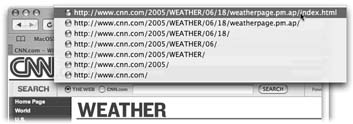 | Figure 21-4. If you x-click the title bar (centered just above the address bar), Safari displays the "ladder" of pages you descended to arrive at the current one. | |
Note: Unfortunately, there's a serious dark side to using this User Agent trick. If enough people pretend that they're using Internet Explorer, whoever created the Web site will never know how many people are actually using Safari ”and will never get around to fixing the Web site.Whenever you encounter a Web site that gives Safari trouble, therefore, you should also (a) take a moment to notify Apple of the problem and (b) notify the Webmaster of the site you're trying to visit that you want Safari compatibility.
21.1.4.4. Where am I? As you dig your way down into a Web site, you may wish you could have left a trail of bread crumbs to mark your path . Ah, but Safari has already thought of that. See Figure 21-4. 21.1.4.5. Faster browsing without graphics Graphics are part of what makes the Web so compelling. But they're also responsible for making Web pages take so long to arrive on the screen. Without them, Web pages appear almost instantaneously ”and you still get fully laid-out Web pages with all their text and headlines. To turn off graphics, choose Safari Preferences and click the Appearance tab. Turn off "Display images when the page opens," and close the Preferences window. Now try visiting a few Web pages and enjoy the substantial speed boost. (And if you wind up on a Web page that's nothing without its pictures, return to Safari Preferences, turn the same checkbox on, and reload the page.) 21.1.4.6. Viewing Web pages offline You don't have to be connected to the Net to read a favorite Web page. You can save a certain Web page on your hard drive so that you can peruse it later ”on your laptop during your commute, for example ”just by choosing File Save As. If you want to save the entire page, along with all its images, movies, and so on, be sure to choose Web Archive from the Format pop-up menu (one of Tiger's most welcome new features). If you're tight on hard drive space, though, choose Page Source instead; you'll still get all the text of the page, but without the fatty multimedia.
Tip: Whenever you buy something online, don't waste paper by printing out the final "This is your receipt" page. Instead, choose File Print and, from the PDF pop-up button, choose Save PDF to Web Receipts folder. Safari saves it as a PDF file into a tidy folder (in your Home Documents folder) called Web Receipts. Nice touch!
21.1.4.7. Sending a page to a friend Safari provides two different ways of telling a friend about the page you're looking at. You might find that useful when you come across a particularly interesting news story, op-ed piece, or burrito recipe. -
The send-the-whole-page method . While looking at a page, choose File Mail Contents of This Page (c-I) to open a new Mail message with a copy of the actual Web page in the body. Address the message and click Send. Bear in mind that your recipient might not be so thrilled about this method. HTML messages (like the ones you send with this technique) are bandwidth-clogging monstrosities, so the message can take a while to download on the other end ” especially over a dial-up connection. And even once it's downloaded, there's no guarantee your recipient will even be able to see the message; some email programs can't display HTML messages at all. -
The send-a-link method . To send just a link to the page you're looking at, choose File Mail Link to This Page (Shift-c-I). Then proceed as usual, addressing the message and clicking Send. Links take only a split second for your recipient to download, and they're guaranteed to display properly in all email programs. All your recipients have to do is click the link to open it in their Web browsers. 21.1.4.8. Designate your home page The first Web site you encounter when Safari connects to the Internet is an Apple Web site. This site is your home page . You'll probably find Web browsing more fun, though, if you specify your favorite Web page as your home page. To do that, navigate your way to the page you prefer. Google, or its news page http://news.google.com, is a good starting place. So is your favorite newspaper home page, or www.macsurfer.com, a summary of the day's Mac news coverage around the world, or maybe www.dilbert.com for today's Dilbert cartoon. Then choose Safari Preferences, click the General tab, and click Set to Current Page (or type the address into the box). FREQUENTLY ASKED QUESTION
Erasing Your Tracks ”and Private Browsing | | So, about this History menu: I'd just as soon my wife/husband/boss/parent/kid not know what Web sites I've been visiting. Must that History menu display my movements quite so proudly ? Some people find it creepy that Safari maintains a complete list of every Web site they've seen recently, right there in plain view of any family member or coworker who wanders by. To delete just one particularly incriminating history listing, click the book icon at the left end of the Bookmarks bar; in the resulting Bookmarks organizer window, click history. Expand the relevant date triangle, highlight the offending address, and then press your Delete key. Click the book icon again to return to normal browsing. You've just rewritten History! Or, to erase the entire History menu, choose History Clear History. Of course, the history menu isn't the only place where you've left footprints. If you choose Safari Reset Safari instead, you also erase all other shreds of your activities: any cookies (Web-page preference files) you've accumulated , your list of past downloads, the cache files (tiny Web graphics files on your hard drive that a browser stores to save time when you return to the page they came from), and so on. This is good information to know; after all, you might be nominated to the Supreme Court some day. That's a lot of work just to cover my tracks; it also erases a lot of valuable cookies, passwords, and History things I'd like to keep. Is all of that really necessary just so I can duck in for an occasional look at the Hot Bods of the Midwestern Tax Preparers' Association home page ? no, it's not. A new Tiger feature called private browsing lets you surf without adding any pages to your history list, searches to your Google search box, passwords to Safari's saved password list, or cookies to your virtual cookie jar. (Apple says that this feature is intended for use at public Macs, where you don't want to reveal anything personal to subsequent visitors . Ha!) The trick is to choose Safari Private Browsing before you start browsing. Once you OK the explanation box, Safari records nothing while you surf. When you're ready to browse " publicly " again, choose Safari Private Browsing so the checkmark goes away. Safari once again begins taking note of the pages you visit ”but it never remembers the earlier ones. In other words, what happens in Private Browsing stays in Private Browsing |
If you can't decide on a home page, or your mood changes from day to day, use the "New windows open with" pop-up menu to choose Empty Page. Some people prefer this setup, which makes Safari load very quickly when you first open it. Once this empty window opens, then you can tell the browser where you want to go today.
Tip: In the Safari Preferences General tab, you can also choose Bookmarks. Then, whenever you open a new window or launch Safari, you can choose exactly which page you want to open by choosing from a list of your bookmarks.
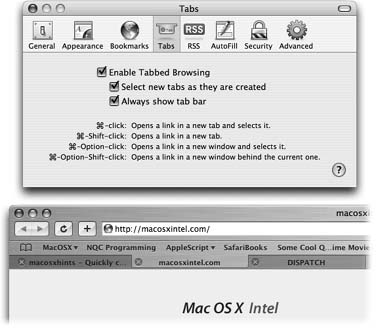 | Figure 21-5. Top: First turn on tabbed browsing in Safari's Preferences
Tabs window. (For best results, also turn on "Select new tabs as they are created.")
Bottom: Now, when you c-click a link, or type an address and press c-Return or c-Enter, you open a new tab, not a new window as you ordinarily would. You can now pop from one open page to another by clicking the tabs just under your Bookmarks bar, or close one by clicking its X button (or pressing c-W). | |
21.1.4.9. Return to the past The History menu lists the Web sites you've visited in the last week or so, neatly organized into subfolders like "Earlier Today" and "Yesterday." (A similar menu appears when you click and hold on the Back or Forward button.) These are great features if you can't recall the URL for a Web site that you remember having visited recently. 21.1.5. Tabbed Browsing Beloved by hardcore surfers the world over, tabbed browsing is a way to keep a bunch of Web pages open simultaneously ”in a single, neat window. Figure 21-5 illustrates. Turning on tabbed browsing unlocks a whole raft of Safari shortcuts and tricks, which are just the sort of thing power surfers gulp down like Gatorade: -
If there's a certain set of Web sites you like to visit daily, put the bookmarks into one folder, using the Bookmarks organizer window (Figure 21-3). You can then load all of them at once into a single tabbed window, simply by selecting the resulting "folder" in the Bookmarks menu ”or the Bookmarks bar ”and choosing Open in Tabs from the submenu. FREQUENTLY ASKED QUESTION
Cookie Control | | Help! I'm afraid of cookies ! Cookies are something like Web page preference files. Certain Web sites ”particularly commercial ones like Amazon.com ”deposit them on your hard drive like little bookmarks, so that they'll remember you the next time you visit. Most cookies are perfectly innocuous ”and, in fact, are extremely helpful, because they help Web sites remember your tastes. Cookies also spare you the effort of having to type in your name, address, credit card number, and so on, every time you visit these Web sites. But fear is widespread, and the media fans the flames with tales of sinister cookies that track your movement on the Web. If you're worried about invasions of privacy, Safari is ready to protect you. Once the browser is open, choose Safari Preferences Security tab. The buttons in this dialog box are like a paranoia gauge. If you click Never, you create an acrylic shield around your Mac. No cookies can come in, and no cookie information can go out. You'll probably find the Web a very inconvenient place; you'll have to re-enter your information upon every visit, and some Web sites may not work properly at all. A good compromise is "Only from sites you navigate to," which accepts cookies from sites you want to visit, but blocks cookies deposited on your hard drive by sites you're not actually visiting ”cookies an especially evil banner ad gives you, for example. note, too, the Show Cookies button, which reveals the shockingly complete list of every cookie you've accumulated so far ”and offers you the chance to delete the ones that don't look so savory. 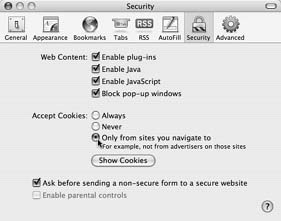 |
The beauty of this arrangement is that you can start reading the first Web page while all of the others load into their own tabs in the background.
Tip: Click the book icon at the left end of the Bookmarks bar. In the Bookmarks organizer, click the Bookmarks Bar item in the left-side list. Now you can see an Auto-Click checkbox for each listed folder.If you turn on this checkmark, then you'll be able to open all the bookmarks in that folder into tabs, all at once, merely by clicking the folder's name in the Bookmarks bar. (If you want to summon the normal menu from the folder, just hold the mouse button down.)
-
If you Option-click a tab's X (close) button, you close all tabs except the one you clicked. The same thing happens if you hold down Option and choose File Close Other Tabs, or if you press Option-c-W. -
If you Option-c-click a link, it opens in a separate window, rather than a new tab. (When tabbed browsing is turned off , you just c-click a link to open a new window.)
Tip: Deep in the guts of Safari is a neatly formatted page that lists nearly every keyboard shortcut in Safari.To see it (so you can print it, perhaps), Control-click the Safari icon in the Finder. Choose Show Package Contents from the shortcut menu. In the new window, open Contents Resources. Finally, drag the icon called Shortcuts.html right into the Safari window.(If you've installed the Debug menu as described on Section 21.1.4, there's an even easier way: Choose Debug Keyboard and Mouse Shortcuts.)
-
If you Shift-c-click a link, Safari opens that page in a tab behind the one you're reading. That's a fantastic trick when you're reading a Web page and see a reference you want to set aside for reading next, but you don't want to interrupt whatever you're reading. 21.1.6. RSS: The Missing Manual In the beginning, the Internet was an informational Garden of Eden. There were no banner ads, pop-ups, flashy animations, or spam messages. Back then, people thought the Internet was the greatest idea ever. Those days, unfortunately, are long gone. Web browsing now entails a constant battle against intrusive advertising and annoying animations. And with the proliferation of Web sites of every kind ”from news sites to personal weblogs ( blogs ) ”just reading your favorite sites can become a full-time job. Enter RSS, a technology that lets you subscribe to feeds ”summary blurbs provided by thousands of sources around the world, from Reuters to Apple to your nerdy next-door neighbor. You use a program like Safari to "subscribe" to updates from such feeds, and then read any new articles or postings at your leisure. The result: You spare yourself the tediousness of checking for updates manually, plus you get to read short summaries of new articles without ads and blinking animations. And if you want to read a full article, you can click its link in the RSS feed to jump straight to the main Web site.
Note: RSS either stands for Rich Site Summary or Really Simple Syndication. Each abbreviation explains one aspect of RSS ”either its summarizing talent or its simplicity.
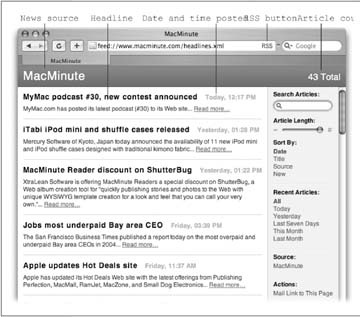 | Figure 21-6. The Length slider controls how much text appears for each RSS blurb; if you drag it all the way to the left, you're left with nothing but headlines. To change the number and order of the articles being displayed, use the search options on the right. And if you feel a sudden desire to tell your friends about an amazing RSS feed you've just discovered , use the "Mail Link to This Page" link in the lower-right section of the window. | |
21.1.7. Viewing an RSS Feed So how do you sign up for these free, automatic RSS "broadcasts?" Watch your address bar as you're surfing the Web. When you see a blue RSS button appear (identified back in Figure 21-1), Safari is telling you, "This site has an RSS feed available." To see what the fuss is all about, click that button. Safari switches into RSS-viewing mode, as shown in Figure 21-6. At this point, you have two choices: -
Add the RSS feed as a bookmark . Use the Bookmarks Add Bookmark command, and add the feed to your Bookmarks menu or Bookmarks bar as you would any Web page. From now on, you'll be able to see whether the RSS feed has had any new articles posted ”without actually having to visit the site. Figure 21-7 has the details. -
Close the RSS feed altogether . To do so, just click the RSS button again. You're left back where you started, at whatever Web page you were visiting. 21.1.8. RSS Tricks RSS is a tremendously flexible and powerful technology, especially in Safari. The fun never ends, as these tricks illustrate . 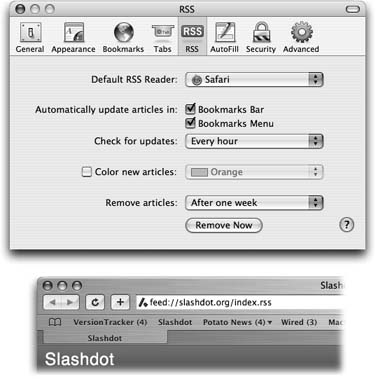 | Figure 21-7. Top: Want to specify when Safari should check for updates to your RSS bookmarks? In Safari Preferences, click RSS. Turn on Bookmarks Bar and Bookmarks Menu. (If you're an especially impatient person, select "Every 30 minutes" from the "Check for updates" pop-up menu.)
Bottom: Next to your RSS feeds' names (in this screenshot, VersionTracker and Wired), a number tells you how many new articles are waiting for you. If you have a bookmark folder containing several RSS feeds in it (here, Potato News), the number reflects the total number of new articles in that folder's feeds. Never again will you have to check a Web site for updates the old-fashioned way. | |
21.1.8.1. Creating RSS summaries If you create a new bookmark folder (Section 2.1.1.2.1) and fill it with RSS feeds, you can see the total number of new articles right next to the folder's name (Figure 21-7, bottom). You might create a folder of Mac news feeds, for instance, so you know whenever there's a important event in the Mac world. From then on, by clicking the folder's name (and opening its pop-up menu), you can see which feeds have new articles; they're the ones with numbers next to their names. If you c-click a bookmark folder's name ”in either the Bookmarks bar or the Bookmarks menu ”Safari shows you all of the feeds, neatly collated into one big, easily digestible list for your perusing pleasure . (If you're billing by the hour , you can also choose View All RSS Articles from the folder's pop-up menu to achieve the same effect.)
Tip: To make the merged list more useful, click New under the Sort By heading. Now Safari displays any new articles at the top of the list, regardless of what site they came from, so you don't have to hunt through the list for new articles yourself.
21.1.8.2. The personal clipping service The search box at the right of any RSS-viewing window works pretty much as you'd expect: It narrows down the list of articles to only those that contain your search terms. But that's barely scratching the surface of the search field's power. If you've adopted the feed-merging trick described above, the Search box can search several feeds at once ”perfect, for example, if you want to see all the news from Mac sites that has to do with iTunes. Now how much would you pay? But get this ”you can then save the search itself as a bookmark. Use the Bookmark This Search link at the lower-right corner of the window. Give the bookmark a name, choose where it should appear in Safari, and click Add. You've just turned Safari into a high-tech personal clipping service. With one click on your new bookmark, you can search all of your favorite news sources simultaneously ”the feeds you've selected ”for the terms you want. You've just saved yourself hours of daily searching ”not to mention the expense of a real clipping service. 21.1.8.3. The RSS screensaver In System Preferences Desktop & Screen Saver Screen Saver tab, you'll find the RSS Visualizer screensaver, one of the most impressive displays of Mac OS X technology you'll ever see. When you click Options and select an RSS feed (and enable screensavers), you set up Mac OS X to get news from that feed whenever you're away from your Mac. When the screensaver comes on, you're treated to a three-dimensional animation of the news from that site ”along with astonished gazes from your co-workers . If a news story grabs your interest, press the number key mentioned at the bottom of the screen. The screensaver fades out, and Safari comes forward to display the associated article.
Tip: But what if the feed you want isn't part of Safari's repertoire ? No problem. Add the feed to your Safari bookmarks and relaunch System Preferences.
21.1.8.4. Make feeds open automatically As described on Section 21.1.4.6, you can easily set up any favorite Web site as your home page, the page that opens automatically whenever you start Safari or create a new window. It turns out, though, that you can also make an RSS feed ”or a list of feeds ”your home page. Open the feeds you want, choose Safari Preferences, click General, and click Set to Current Page. In other words, suppose you start by opening a list of local, national, international, business, and sports news feeds. In that case, you've just made yourself a fantastic imitation of newspaper headlines, but tailored to your interests with spectacular precision: The Francis J. McQuaid Times (or whatever your name is).
Tip: If you've turned on tabbed browsing (Section 21.1.4.9), you can Shift-c-click headlines. That makes the full articles open in background tabs while you continue to read the headlines.
Articles in this Safari-newspaper arrangement are timelier than anything you could read in print ”and they're completely free. If you miss a day of reading the headlines, no problem; the headlines stick around for days, and disappear only once you've read them. And finally, when you're done reading, you don't have to worry about recycling your "newspaper." No trees were harmed in the making of this publication. Welcome to the future of news: customized, free, up-to-date, and paperless.
Tip: To find more RSS feeds, visit a site like www. feedster .com or www.syndic8.com, or just watch for the appearance of the blue RSS button in the Address bar.By the way, Safari isn't the only RSS reader. If you catch the RSS bug, you might want to try out a program like NetNewsWire (http://ranchero.com/netnewswire/), which offers many more power-user features.
|







